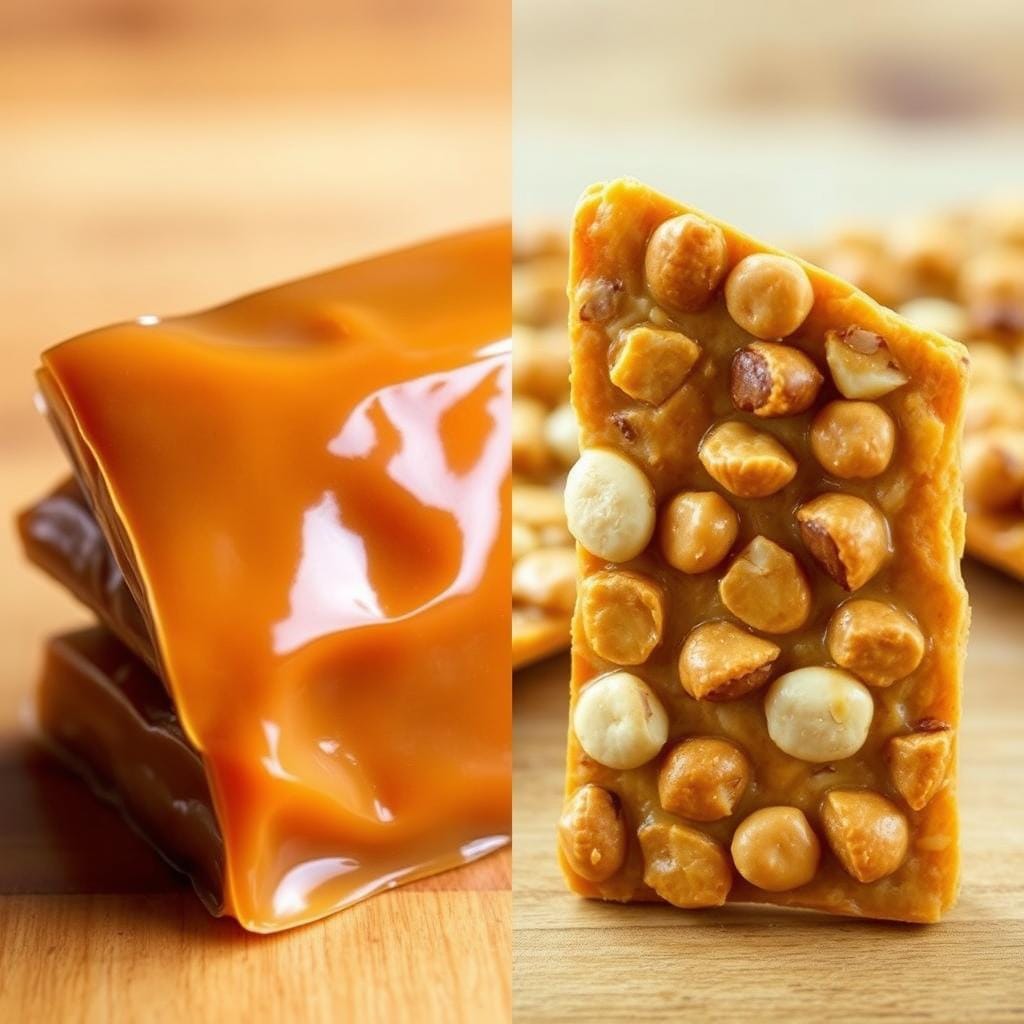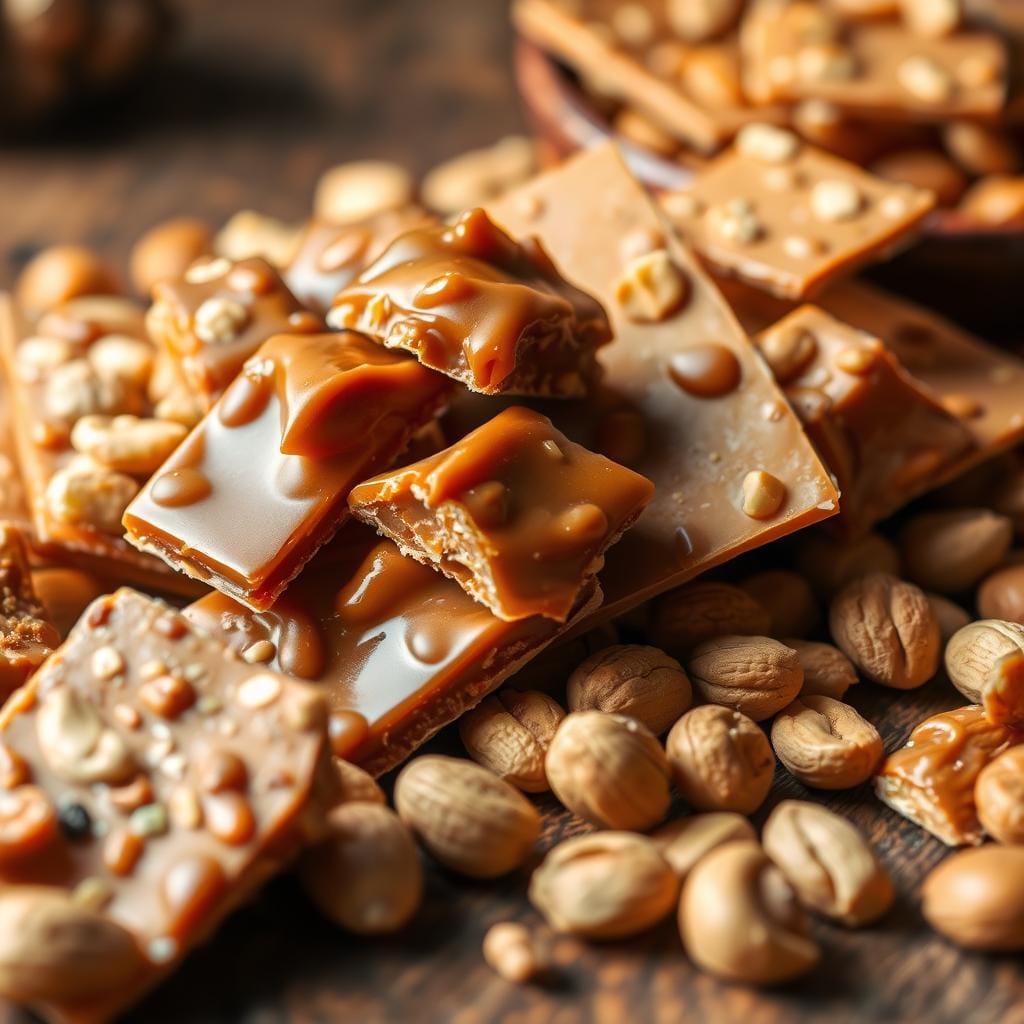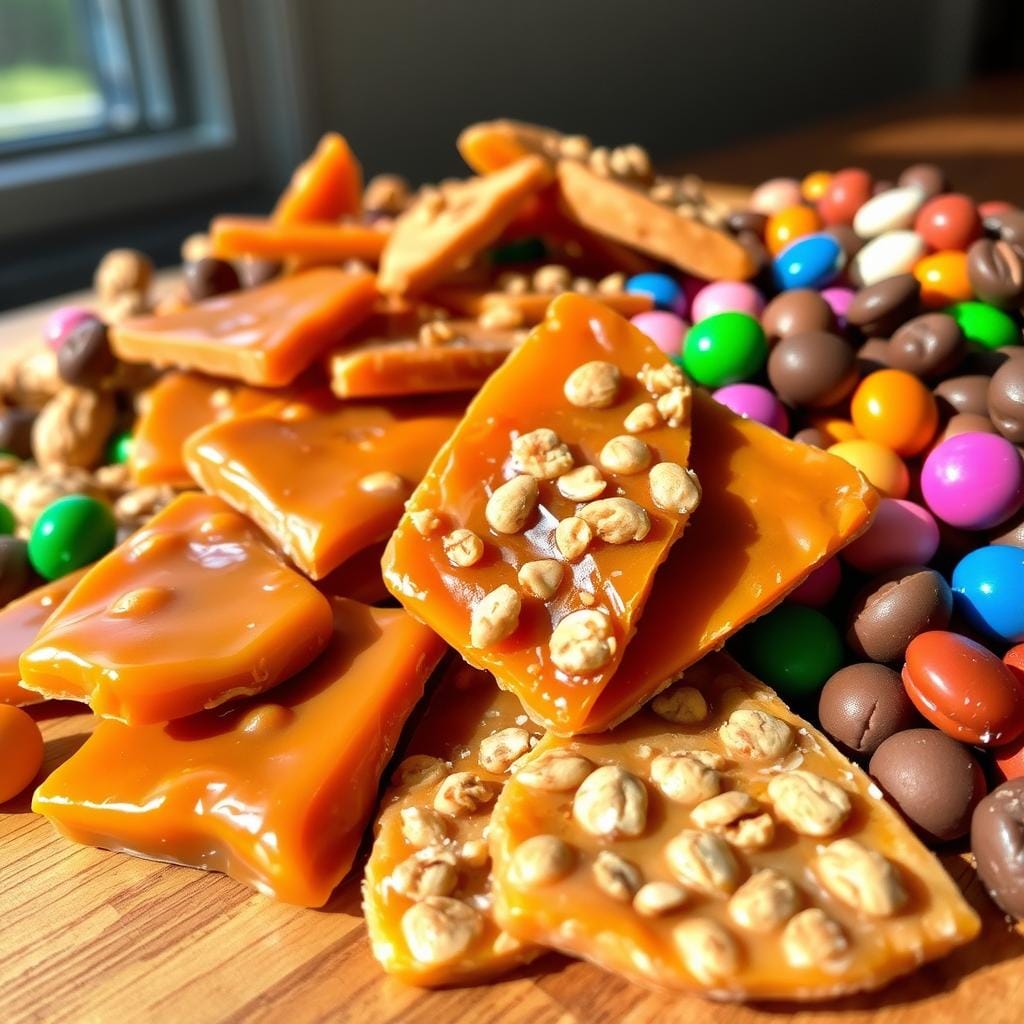I love exploring the world of candies! Toffee’s rich, buttery flavor and peanut brittle’s crunchy texture always bring me joy. What’s the difference between toffee and peanut brittle? Let’s dive into their delicious world to discover what sets these treats apart.
Key Takeaways
- Toffee and peanut brittle are distinct candy varieties with unique textures and flavors.
- Toffee is a chewy, caramel-like confection, while peanut brittle is a crunchy, nutty treat.
- The origins and history of these candies are deeply rooted in different culinary traditions.
- Toffee and peanut brittle differ in their basic ingredients, cooking methods, and nutritional profiles.
- Both candies offer a wide range of variations and flavor combinations to satisfy diverse palates.
What’s the difference between toffee and peanut brittle?
Toffee and peanut brittle are two sweet treats that many wonder about. They are both made from sugar, but they have different tastes and textures. Let’s explore what makes them unique.
Toffee is made by cooking sugar, butter, and sometimes cream or milk. This process creates a rich, chewy treat. In contrast, peanut brittle is made by coating peanuts in a hard sugar syrup. This makes it crunchy and candy-like.
| Toffee | Peanut Brittle |
|---|---|
| Made with sugar, butter, and cream/milk | Made with sugar syrup and roasted peanuts |
| Chewy and soft texture | Crunchy and brittle texture |
| Caramelized flavor | Peanut-forward flavor |
The textures of these treats are also different. Toffee is chewy because of the slow caramelization. Peanut brittle is crunchy because of the quick cooling of the sugar syrup around the peanuts.

Whether you like the buttery taste of toffee or the crunch of peanut brittle, both are irresistible. They offer a delightful contrast in flavor and texture.
Origins and History of Toffee and Peanut Brittle
Toffee and peanut brittle are two candy varieties with deep histories. They come from different places and cultures. These cultural sweets have become loved by people all over the world.
Traditional British Toffee Making
Toffee started in 17th-century Britain. It became a favorite treat. Making toffee involves cooking sugar, butter, and sometimes cream until it’s chewy.
This method has been passed down for generations. It’s a key part of British confectionery types.
American Peanut Brittle Evolution
Peanut brittle began in the late 19th century in the United States. It started as a local candy variety. But as it became more popular, it spread across the country.
Cultural Significance in Confectionery
Toffee and peanut brittle hold special places in their cultures. In Britain, toffee is linked to cozy winter times and memories. In the US, peanut brittle is a key part of holidays.
These cultural sweets are more than just candy varieties. They are part of their countries’ culinary heritage.

The love for toffee and peanut brittle shows their lasting charm. They are a big part of the global cultural sweets scene.
Basic Ingredients and Components
Making tasty sugar snacks like toffee and peanut brittle starts with the same basic ingredients. They mix sweet and savory parts to get their special tastes and textures. Let’s look at what makes these caramel treats and nutty sweets so loved.
Toffee and peanut brittle both need key ingredients to be their best. Toffee has butter, sugar, and sometimes cream or milk. These melt together to make a chewy, caramel-like treat. Peanut brittle, on the other hand, uses sugar, corn syrup, and roasted peanuts. This mix creates a crunchy, nutty snack.
| Ingredient | Toffee | Peanut Brittle |
|---|---|---|
| Sugar | ✔ | ✔ |
| Butter | ✔ | |
| Cream or Milk | ✔ | |
| Corn Syrup | ✔ | |
| Peanuts | ✔ |
Even though they share some ingredients, toffee and peanut brittle recipes are different. This lets chefs try new flavors, textures, and styles. It keeps these sugar snacks exciting and loved by people everywhere.
Texture Comparison: Soft vs Brittle
Toffee and peanut brittle are two candies with unique textures. Toffee is soft and chewy, while peanut brittle is crispy and shatters when you bite into it. These differences make each candy special in its own way.
Toffee’s Chewy Nature
Toffee gets its chewiness from butter, sugar, and sometimes milk or cream. When cooked, the sugar caramelizes, making the toffee soft and velvety. This texture is perfect for enjoying slowly.
Peanut Brittle’s Crispy Character
Peanut brittle is known for its crunch. It’s made by cooking sugar and water to a high temperature. This makes it thin and crisp. The nuts in it add to its crunchy feel.
Temperature Effects on Texture
The cooking temperature affects the texture of these candies. Toffee is cooked at a lower temperature, making it soft. Peanut brittle is cooked at a higher temperature, making it crispy. This temperature difference is what makes toffee and brittle different.
| Candy Variety | Texture | Cooking Temperature |
|---|---|---|
| Toffee | Soft, Chewy | Lower Temperature |
| Peanut Brittle | Crispy, Crunchy | Higher Temperature |
“The contrasting textures of toffee and peanut brittle are what make these confections so unique and delightful to enjoy.”
Cooking Methods and Techniques
Creating delicious toffee and peanut brittle is all about the cooking methods. These methods are as important as the ingredients. They give each confectionery type its own special texture and taste.
Toffee: A Slow, Precise Process
Making toffee is a slow and careful process. Preparation methods involve heating sugar, butter, and sometimes cream or milk slowly. This careful heating turns sugar into a rich, golden-brown toffee.
Peanut Brittle: Quick and Crisp
Peanut brittle is made quickly with high heat. The sugar is heated to a very high temperature. This makes the candy crunchy and shatteringly crisp. Peanuts are added quickly, and the mixture is poured to cool and harden.
Toffee and peanut brittle both start with sugar. But their preparation methods make them unique. These methods are what set these confectionery types apart.
Nutritional Value and Dietary Considerations
Toffee and peanut brittle have different nutritional values. It’s key to know the calories, protein, fat, and sugar in these treats. This knowledge helps you make better choices for your diet and health.
Caloric Content Comparison
Toffee is often more calorie-dense than peanut brittle. A single toffee piece can have 80 to 120 calories. Meanwhile, peanut brittle has about 50 to 80 calories for the same size. This is because toffee has more fat and sugar.
Protein and Fat Content
Peanut brittle gets its protein and healthy fats from peanuts. Toffee, made with butter and sugar, has less protein and more saturated fats.
Sugar Levels and Health Impact
| Nutrient | Toffee | Peanut Brittle |
|---|---|---|
| Total Sugars | 20-25g per serving | 10-15g per serving |
| Health Considerations | High sugar content can contribute to weight gain, blood sugar spikes, and increased risk of chronic health conditions like diabetes and heart disease. | Moderate sugar levels, combined with the protein and healthy fats from peanuts, make peanut brittle a relatively better choice for occasional indulgence. |
Both toffee and peanut brittle should be enjoyed in moderation. But, toffee’s higher sugar content means it’s more important to be careful, especially for those with dietary restrictions or health issues.
Storage Requirements and Shelf Life
Keeping toffee and peanut brittle fresh is key. You need to think about how to store them right. This helps keep their taste and texture good for longer.
Knowing how to store each candy is important. Toffee is softer and lasts less than peanut brittle. Storing them well helps you enjoy them longer.
Toffee Storage and Shelf Life
- Keep toffee in a sealed container at room temperature. Stay away from sunlight and heat.
- Toffee lasts about 2-4 weeks if stored right.
- For longer freshness, chill toffee. It can last 4-6 weeks in the fridge.
Peanut Brittle Storage and Shelf Life
- Store peanut brittle in a sealed container at room temperature. Keep it away from moisture.
- Peanut brittle can last 4-6 weeks if stored correctly.
- Don’t put peanut brittle in the fridge. The cold can mess up its freshness.
It’s vital to check if your candy is still fresh. Look for signs like softening or losing crispness. Enjoy them within the recommended time for the best taste.
“Proper storage is the key to maintaining the quality and longevity of your beloved toffee and peanut brittle creations.”
Popular Variations and Flavor Combinations
In the world of toffee and peanut brittle, new flavors and mixes are all the rage. Bakers and candy makers are always trying new things. They add unexpected twists and global flavors to these classic treats.
Modern Toffee Innovations
Toffee lovers can now enjoy many caramel treats beyond the usual butterscotch. You can find chocolate-dipped toffee and toffee with sea salt. Some makers even add nuts like pecans or almonds, making the flavors even more exciting.
Regional Brittle Varieties
Peanut brittle has also seen a lot of changes. The American South is famous for its peanut brittle, but other places have their own versions. In the Southwest, you might find brittle with Mexican spices. On the West Coast, brittle made with local nuts like almonds is very popular.
| Toffee Variation | Peanut Brittle Specialty |
|---|---|
| Chocolate-Dipped Toffee | Southwestern Spiced Brittle |
| Sea Salt Caramel Toffee | Almond Brittle |
| Pecan Toffee | Cashew Brittle |
The world of toffee and peanut brittle is full of endless possibilities. This lets candy lovers explore a wide range of caramel treats and nutty sweets. There’s something for everyone, no matter what you like.
Common Uses in Desserts and Baking
Toffee and peanut brittle are great in the kitchen. They add a special touch to many desserts and baked goods. Their mix of textures and tastes makes them perfect for many recipes.
They’re often used as toppings for cakes, pies, and ice cream. Their sweet and crunchy qualities make desserts even better. You can also mix them into cheesecakes, brownies, and cookies for a fun surprise.
| Dessert Idea | Toffee Application | Peanut Brittle Application |
|---|---|---|
| Chocolate Cake | Toffee chunks or shards as a topping | Crushed peanut brittle mixed into the frosting |
| Vanilla Ice Cream | Toffee bits or crumbles sprinkled on top | Peanut brittle pieces scattered over the scoops |
| Pecan Pie | Toffee drizzle or swirls along the top | Peanut brittle crumbs in the filling |
Toffee and peanut brittle are also great in baked goods. Crushed toffee can be added to cookies, scones, and muffins. Chopped peanut brittle is perfect for granola bars, trail mixes, and even pancake or waffle batter.
These treats are very versatile. They can be used in many ways, making any dish more exciting. Their unique qualities are sure to please anyone’s taste buds.
Making These Treats at Home: Tips and Tricks
If you love candy making and want to make confections at home, toffee and peanut brittle are great choices. With the right preparation methods, you can make these treats in your kitchen. Here are the essential tools and common mistakes to avoid.
Essential Equipment Needed
To start making homemade confections, you need a few tools. A heavy-bottomed saucepan or pot is key for even cooking. A candy thermometer is crucial for the right temperature. Also, a silicone baking mat or parchment paper makes removal and cleanup easy.
Common Mistakes to Avoid
- Overcooking the sugar mixture, leading to a burnt or bitter taste.
- Failing to properly grease the baking surface, resulting in the candy sticking to the pan.
- Stirring the mixture too frequently, which can cause sugar crystals to form and affect the final texture.
- Letting the candy cool too quickly, resulting in a grainy or uneven texture.
By avoiding these common mistakes and following best practices, you can make delicious homemade confections. Your creations will be as good as those from candy making pros.
| Essential Equipment for Homemade Toffee and Peanut Brittle | Why It’s Important |
|---|---|
| Heavy-bottomed saucepan or pot | Ensures even heating and prevents burning of the sugar mixture. |
| Candy thermometer | Allows you to accurately monitor the temperature and achieve the right texture. |
| Silicone baking mat or parchment paper | Facilitates easy removal and cleanup of the candy once it has cooled. |
Commercial Brands and Market Availability
The demand for candy like toffee and peanut brittle is on the rise. Today, you can find many commercial options. These range from classic recipes to new and exciting flavors.
Werther’s Original is a well-known toffee brand in the U.S. It comes from Germany and is famous for its smooth, buttery taste. Heath Bar is another favorite, offering a toffee-based candy bar covered in milk chocolate.
Fairfield Candy Company is a trusted name in peanut brittle. They make high-quality, handcrafted brittle. Granny’s Homemade Peanut Brittle is also popular for its use of the finest ingredients and traditional techniques.
New brands are also making waves in the candy market. Peanut Butter Brittle by Bella’s Gourmet Foods and Salted Caramel Toffee by Gourmet Toffee Company are examples of innovative candies.
Whether you love classic flavors or want to try something new, there’s something for everyone. The market offers a wide range of toffee and peanut brittle options. This means you can indulge in these treats more than ever before.
Conclusion
In the world of sweets, toffee and peanut brittle are two favorites. They differ in their beginnings, ingredients, textures, and uses. Toffee is soft and chewy, while peanut brittle is crunchy.
Both are loved in the U.S. and worldwide. They bring joy with their unique tastes and history. Enjoying these treats shows the hard work and tradition behind them.
Choosing between toffee and peanut brittle depends on what you like and when. They’re both great for satisfying your sweet tooth. Next time you want something sweet, try toffee or peanut brittle and find your new favorite candy.

